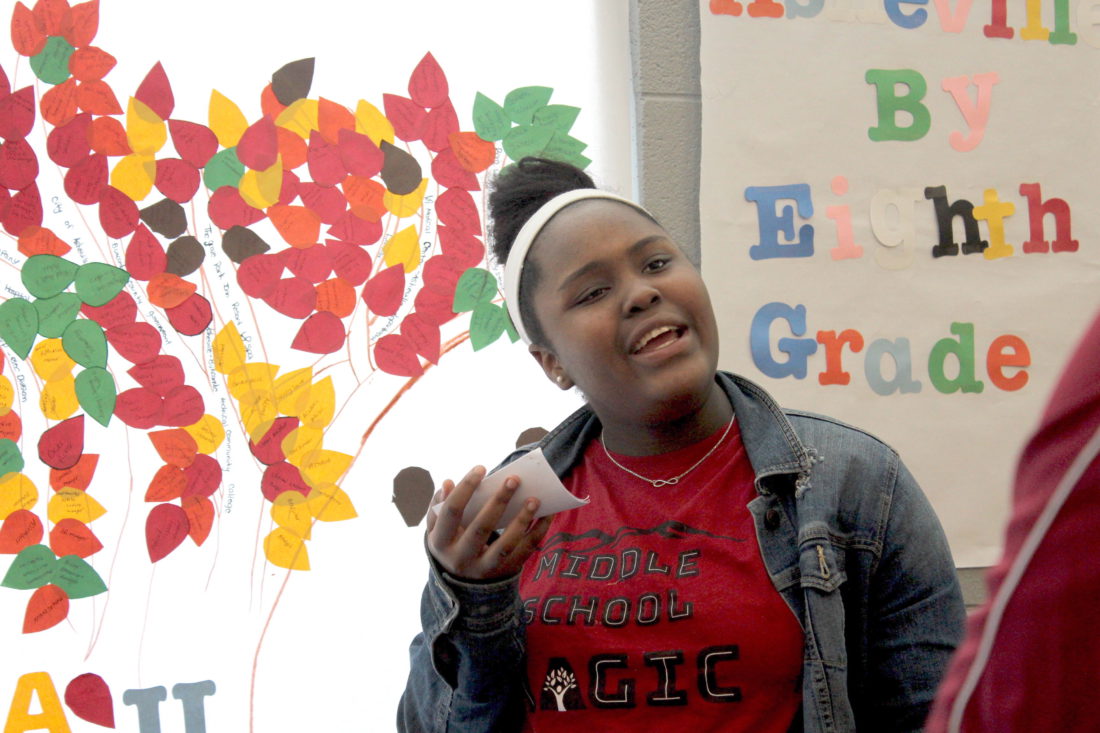Rising sixth, seventh and eighth grade students participating in the Middle School Magic program presented their findings to community members on July 25, the final day of the three-week summer enrichment series held at Asheville Middle School.
About 45 students explored different aspects of the city’s African American history and its lasting effects. “We really wanted to give students a platform to have their voices heard and have their understandings of inequities in our city heard,” explained Ann O’Brien, a sixth grade language arts teacher at Asheville Middle. “We’re talking about it, we’re thinking about it as staff, but we don’t always get a chance to listen to students.”
“Gentrification is when people with money come into a neighborhood and just clear it out and make profits galore by renovating and buying more land because they are so greedy,” said Makyan, a rising sixth grader. “The prices go up for poor people, and then they cannot stay anymore, because that’s the reason why they were there — because they were poor.”
Melissa, another rising sixth grader, talked about her newfound knowledge of a prominent African American from Asheville’s history. “E.W. Pearson made the first African American baseball team,” she said. “My neighborhood, which he founded, was Burton Street. Which is going to be replaced with a highway.”
The students wrote a letter to Asheville City Council with recommendations based on what they learned. The 11- and 12-year-olds urged adding markers at sites with significance for Asheville’s African American history, returning South Charlotte Street to its original name of Valley Street and cleaning up broken glass in Triangle Park. In the Burton Street neighborhood, the students said, the city should install garbage cans, organize a community cleanup and stop plans to remove residents’ homes to make way for the Interstate 26 Connector.
Rising seventh grade students created a gallery of artwork to express their interpretations of Asheville’s past, present and future. A poster outlining urban renewal read, “Urban renewal was very complicated. Thousands of residents of Southside were removed. Many were elderly and they didn’t come back. Economic development was good for city. Bad for people.”
Another poster titled “State of Black Asheville” featured phrases including, “On the surface it’s OK. Under the surface it’s not OK” and “The danger that you feel is real.” The poster also traced the percentage of Asheville’s population made up of black residents, from 25% at the end of World War II to 18% in the 1980s, 13% in 2010 and a projected 6% in 2020.
Soon-to-be eighth grade students explored education and employment opportunities, including through tours of the Grove Park Inn, Linamar, Eaton Corp. and A-B Tech. Zykia said, “We feel as minorities that the service industry is pushed to us as an expectation. Minorities always have the hidden jobs, like being in the kitchen and housekeeping. Linamar and Eaton showed us what equity looks like in the workforce.” Students saw similar numbers of employees of color and white workers in various roles at those businesses, she said.
Student Mariela said she’d like to see more teachers of color in Asheville City Schools, “because it would help the students feel more comfortable. We would like more teachers of different races and different colors to encourage the students to keep on learning.” Zykia agreed, saying, “We’d like to have more people we can come to in certain situations and they can relate to us.”
A video created by the rising eighth grade group stated, “It’s a different year, a different generation. And things are not the same as before.”
Editor’s note: The spelling of rising eighth grade student Zykia’s name has been corrected from an earlier version of this article.




It is evident by Makyan’s comment that ‘gentrification’ is a BAD word and something that only rich people ‘do’… Gentrification is GOOD for cities, not BAD. Prime example of why you should get your children OUT of government screwels … NOW!
Gentrification is not good for cities, it is good for investors. It erases the cultures that make a city unique in favor of homogenizing white interests. Investment in the *people* of underserved communities instead of grabbing at the real estate assets of the location is what helps a city. Ensuring quality, culturally competent schools; well planned and maintained infrastructure; wealth building instead of displacement; intergenerational networking- that grows thriving communities which link into a vibrant, successful city.
indoctrinated much?